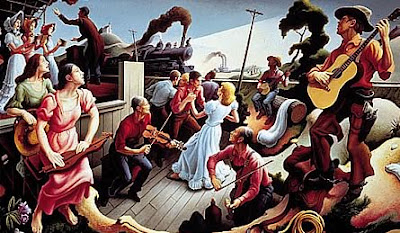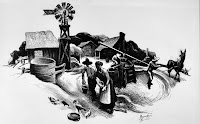Thomas Hart Benton’s acclaim came from his development of the Regionalist painting style, which rejected the aristocracy of the predominating art culture to show the common man. Studying at both the Art Institute of Chicago and the Académie Julian in Paris, Benton returned to the States in 1913 and continued to pursue painting until serving in the Navy during WWI.
 |
| One of the series from The Arts of Life in America. |
After his involvement in the war, Benton gained acclaim in the early 30s. One of Benton’s most famous works, a set of large murals for the Whitney Museum (now at the New Britain Museum of American Art), is entitled The Arts of Life in America and spans five sections. Benton’s regionalism – an art style that raised the status of the American heartland despite the bleak reality of the Great Depression – led to a Time Magazine cover in Dec. 1934.
 |
| The Sources of Country Music. |
Benton continued to work through WWII, and died aged 85 in 1975 after completing his final mural The Sources of Country Music.
While most famous for his murals, Benton also created many lithographs, now on view through May 27 as part of the Resilience exhibition. The lithographs on view at the FAC were made at the beginning of the Depression era.
In the Field: Depression Era Works by Thomas Hart Benton and Boris Deutsch
March 17 – May 27, 2012


